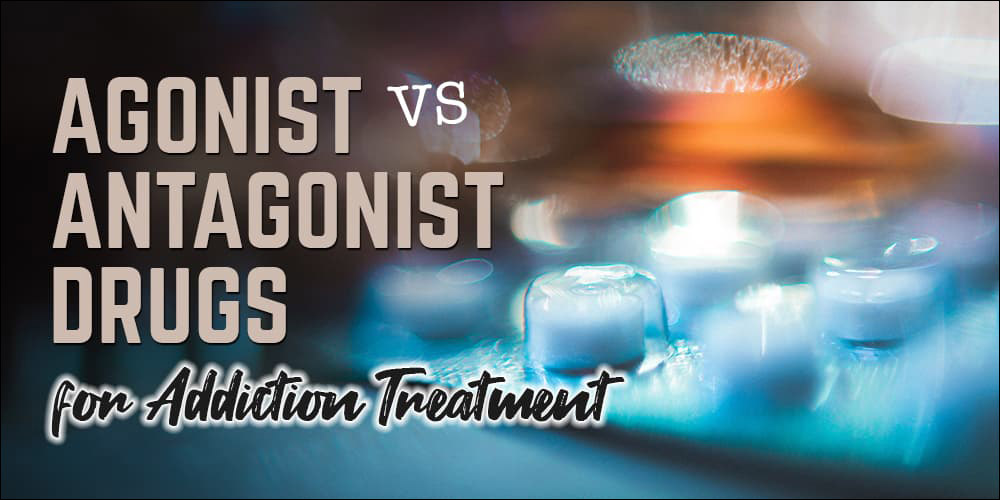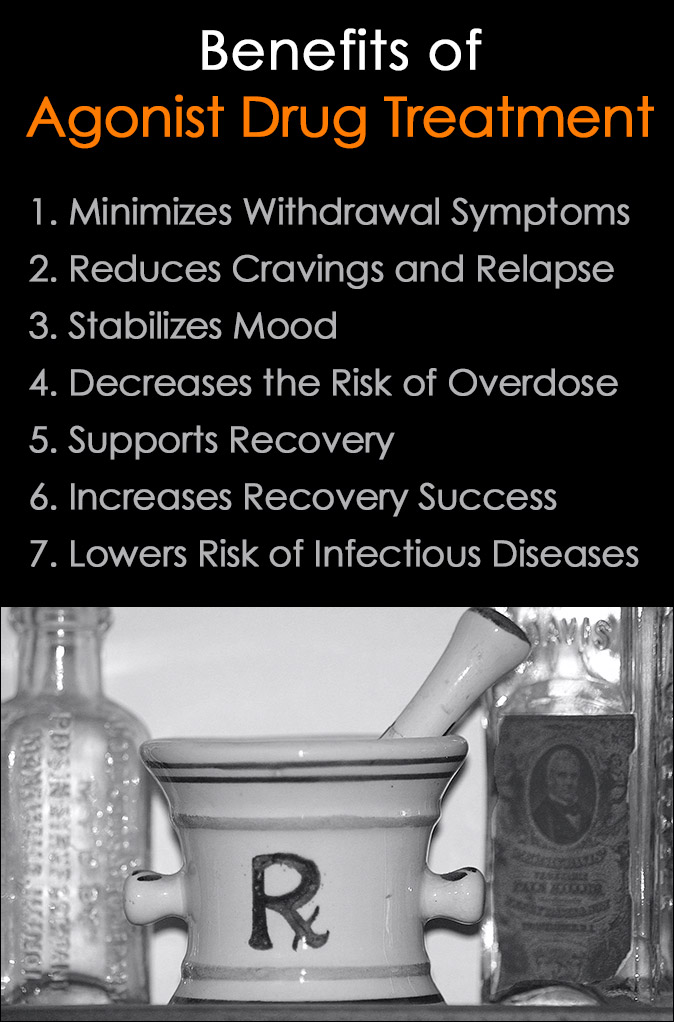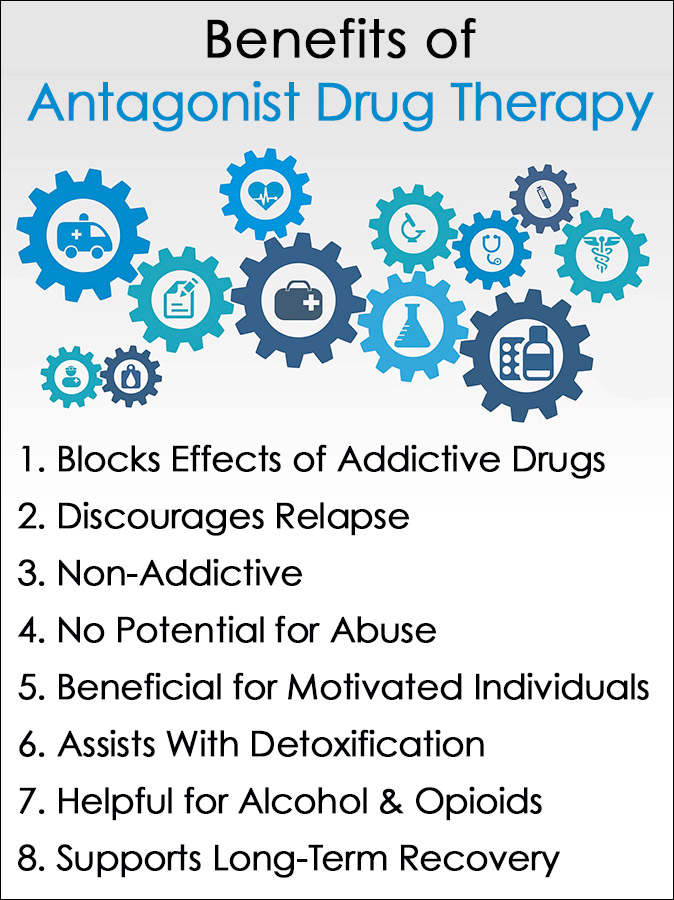
It’s important to understand the difference between agonist vs antagonist drugs used as part of a comprehensive addiction treatment program.
Addiction and overdose deaths present a unique health challenge to society. One-size fits all treatment approaches are not effective, so recovery methods must be customized for each person’s particular needs and type of substance use.
In recent years, Medication Assisted Treatment (MAT) has shown to be one of the most successful ways of treating addiction to opioids and other drugs.
MAT uses agonist and antagonist drugs as part of an integrated addiction treatment program to reduce withdrawal symptoms, manage cravings, and decrease the chances for relapse and overdose.
Antagonist and agonist drugs work in different ways and each has distinct benefits for use.
Learning about the differences between these types of drugs and how they are used can help people seeking treatment find the most appropriate solutions for recovery.
What is the Difference Between Agonist vs Antagonist Drugs?
The most basic difference between agonist vs antagonist drugs is the way they work.
An agonist drug “stimulates” specific receptors in the brain to mimic the effect of addictive drugs like heroin and opioids.
Agonist drug therapy is often used for reducing withdrawal symptoms and cravings by partially activating receptors in the brain to help manage the physiological and psychological aspects associated with addiction.
An antagonist drug creates the opposite effect and “blocks” receptors in the brain to prevent abused substances like heroin and opioids from producing their normal effects.
Antagonists essentially stop a user from feeling high when using addictive drugs to act as a deterrent instead of reducing withdrawal symptoms.
Choosing between agonist vs antagonist drugs for treatment will depend on various factors, such as the type of substances an individual is addicted to, and his or her current stage of treatment or recovery.
What is an Agonist Drug?
An agonist drug activates receptors in the brain similar to other addictive drugs, except with less intensity.
Agonist drug therapy has shown to help manage withdrawal symptoms, decrease cravings, and prevent relapse for many people struggling with addiction and substance use disorders.
Many times, agonist drugs are used early in recovery during a drug detox program to manage withdrawal symptoms, and also in the initial stages of addiction treatment to help reduce cravings.
As treatment and recovery progresses, the dosage of agonist drugs can be gradually tapered off or discontinued when appropriate.
Agonist Drug Examples
There are several different types of agonist drugs used for addiction treatment.
1. Methadone
Methadone is probably the most well-known agonist drug example and it is used for people addicted to prescription opioid painkillers, as well as heroin, and fentanyl.
Methadone stimulates opioid receptors in the brain, but it is not as intense as other opiate drugs, with the goal of minimizing cravings and withdrawal symptoms.
Methadone is usually administered only in a specialized methadone clinic.
2. Buprenorphine
Buprenorphine is a widely used agonist drug for opioid addiction treatment and is available in a range of formulations such as:
- Subutex (Sublingual Buprenorphine)
- Sublocade (Buprenorphine Injection)
- Zubsolv (Buprenorphine and Naloxone)
- Probuphine (Buprenorphine Implant)
Buprenorphine is considered a partial agonist that is effective for decreasing opioid cravings. It has milder side effects and a lower potential for misuse and abuse than full agonists like methadone.
3. Suboxone
Suboxone is a combination medication that contains both an agonist drug (Buprenorphine) and an antagonist drug (Naloxone).
It is used for addiction treatment, primarily to manage opioid dependence.
The two main active ingredients in Suboxone are:
- Buprenorphine
- Naloxone
The agonist Buprenorphine mildly stimulates opioid receptors in the brain to minimize withdrawal symptoms and drug cravings.
The antagonist Naloxone blocks the stimulation of opioid receptors to deter individuals from using drugs like heroin and fentanyl, and also reverses the effect of opioid drugs.
Like the other agonist and antagonist drugs mentioned here, Suboxone is considered an important Medication for Opioid Use Disorder (MOUD) that is part of a medication assisted treatment strategy.

Benefits of Agonist Drugs for Addiction Treatment
Agonist drugs are useful for treating opiate addiction, including heroin, fentanyl, morphine, oxycodone, and other prescription opioids.
Agonist Drug Benefits
1. Minimizes Withdrawal Symptoms
Agonist drugs help minimize the discomfort of withdrawal symptoms by activating receptors in the brain to simulate the effects of the addictive substance a person is trying to quit.
2. Reduces Cravings and Relapse
Agonists target the same receptors as the addictive substance, which reduces cravings and the likelihood of a relapse.
3. Stabilizes Mood
Agonist drug therapy helps to stabilize mood swings that often arise during detox, withdrawal, and addiction recovery.
4. Decreases the Risk of Overdose
When used as directed, and part of a medication assisted treatment program, agonist drugs have a lower risk of overdose compared to the addictive substances they are intended to replace.
5. Supports Recovery
By mimnimizing cravings and withdrawal symptoms, agonist therapy supports recovery by allowing individuals to concentrate on therapy and make positive lifestyle changes.
6. Increases Recovery Success
Reducing cravings, withdrawal symptoms, and the risk of relapse from agonist therapy often leads to higher retention rates in addiction treatment programs and increases the success of recovery.
7. Lowers the Risk of Infectious Diseases
Agonist drug treatment can decrease the use of shared needles, which lowers the risk of contracting infectious diseases, such as HIV and hepatitis.
What are Antagonist Drugs?
Antagonist drugs block specific receptors in the brain, preventing addictive substances from binding to them and producing their usual effects.
By blocking brain receptors, antagonist drugs deter people from using addictive substances like opioids and heroin because they will not feel the pleasurable sensations they normally produce.
Antagonist drugs are often suitable for individuals in the later stages of recovery when they are more stable and motivated to abstain from drug use. They serve as an additional layer of support to prevent relapse.
Examples of Antagonist Drugs
1. Naltrexone
Naltrexone is an antagonist drug used for both alcohol and opioid addiction treatment.
It works by blocking the receptors that opioids and alcohol bind to in the brain to reduce the pleasurable effects they produce.
Naltrexone is available in both oral and extended-release injectable formulations.
2. Disulfiram
Disulfiram, also known as Antabuse, is an antagonist drug used primarily for alcohol addiction treatment.
When a person taking Antabuse consumes alcohol, it causes an uncomfortable reaction, including nausea and dizziness that discourages drinking alcohol again.
3. Naloxone
Naloxone is an antagonist drug that blocks the effects of opiates, heroin, and fentanyl, by binding to opioid receptors in the brain that those drugs normally target.
Also known as Narcan, Naloxone is used to reverse opioid overdoses and is an essential medication for emergency medical situations.
When a person overdoses on heroin or fentanyl, the respiratory system becomes severely depressed and fails.
Naloxone quickly binds to opioid receptors in the brain to reverse the effects and restore normal respiration to prevent an overdose death.
Naloxone is not used as a treatment for addiction, although it is an essential harm reduction tool to reduce the risk of overdose for individuals who are addicted to opioids.

Benefits of Antagonist Drugs for Addiction Treatment
Antagonist drugs are effective for treating alcohol addiction and opioid addiction. By acting as a deterrent to drug use, they help to prevent relapse.
Antagonist Drug Therapy Benefits
1. Blocks the Effects of Addictive Substances
Antagonist drugs bind to the same receptors in the brain as other addictive substances and block the pleasurable effects and feelings of reward.
2. Discourages Relapse
By preventing the pleasurable feelings associated with drug use, antagonist drugs act as a deterrent that discourages relapse and substance abuse.
3. Non-Addictive
Antagonist drugs do not produce euphoria or lead to a tolerance, making them non-addictive and safe for long-term use in addiction treatment.
4. Low or No Potential for Abuse
Unlike some agonist drugs, antagonist medications are not considered to have any potential for abuse, so there is not a risk of dependence.
5. Beneficial for Motivated Individuals
Antagonist drugs are particularly beneficial for individuals who are highly motivated to maintain abstinence from addictive substances.
6. Assists With Detoxification
Antagonist drugs can be used during the drug detox process to help manage withdrawal symptoms and also reduce the risk of relapse.
7. Helpful for Alcohol Dependence and Opioid Addiction
Antagonist drugs like Naltrexone are specifically used to treat alcohol addiction by reducing cravings and preventing relapse.
8. Supports Long-Term Recovery
Antagonist drug therapy can be used as part of a comprehensive treatment plan to support long-term recovery and reduce the chances of a relapse.
Agonist vs Antagonist Therapy for Addiction Treatment and Detox
Agonist and antagonist drugs play an important role in addiction treatment and detox today.
With the rates of addiction and overdoses increasing each year, seeking professional treatment offers the best chance for a successful recovery.
The opioid epidemic led to a heroin epidemic, and in turn, fentanyl has made the situation even more dangerous and deadly.
Effective fentanyl detox and addiction treatment, combined with medications for opioid use disorder, may be the only hope many people have for recovery.
Choosing between agonist vs antagonist drugs, or a combination of both, depends on each person’s individual needs, medical history, and his or her stage of addiction and recovery.
Qualified addiction treatment professionals will determine the most suitable and personalized approach for recovery.
Agonist and antagonist therapy is most effective when used as part of a comprehensive treatment plan that includes detox, evidence-based behavioral therapies, counseling, and other support services.
Addiction is a treatable condition, and seeking appropriate treatment and support will significantly increase the chances of successful recovery and a healthier and more fulfilling life.
Related Posts
- Evidence-Based Treatment for Addiction
For anyone seeking treatment for addiction and mental health issues, it can be difficult and…
- 8 Famous People Who Kicked Their Cocaine Addiction
People are often influenced by the rich and famous, and sadly that can mean normalizing…
- Alcohol Dementia Causes, Symptoms and Treatment
Note: Alcohol Dementia goes by many names including, alcohol-related dementia, alcoholic dementia, and alcohol-induced dementia.…
